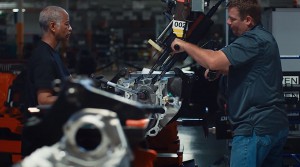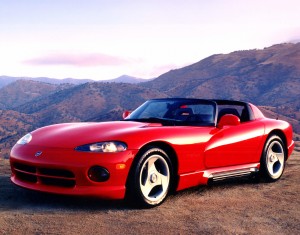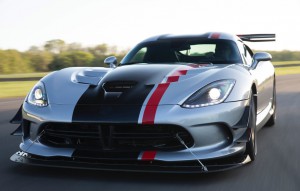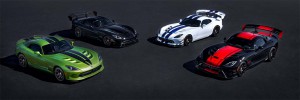
Members of Team Viper ready an engine for installation into a new Dodge Viper. The plant is being shut down and Viper production ended for good.
Barely five years after bringing the Dodge Viper back to life, Fiat Chrysler Automobiles will end production and permanently shut down the special Detroit assembly line tasked with building the two-seat sports car.
A total of just 87 workers will be impacted by the closure of the Conner Avenue Assembly Plant on Detroit’s east side, but FCA plans to offer all of them work at some of its other facilities.
First introduced in roadster trim in 1992, what fans preferred to call the “Snake” was one of the fastest products the automakers has ever built, but the $85,000 price tag was simply too much for most Dodge buyers, said Tim Kuniskis, head of Dodge and other North American passenger car operations. Ironically he told TheDetroitBureau.com, that sales of the Viper ACR model has actually been picking up as production of the Viper gets ready to shut down.
“We can’t build them fast enough,” said Kuniskis, referring specifically to the “Ultimate Viper” edition. The ACR starts at $119,000 but can push up to nearly $150,000 fully equipped.
(For more about the demise of the Viper, Click Here.)

The original Viper was conceived during the "darkest hour" of Chrysler's life, according to one executive.
The top-line version of the fifth-generation Viper coupe appeals to a very different buyer than the base model, including customers who might also have products like a Ferrari, Lamborghini or Aston Martin in the garage. By comparison, even the most expensive of Viper models come as a relative bargain. Speculators have also been snapping up the top-end Vipers hoping that they will eventually become collectible models worth far more than sticker price.
Overall, Viper sales are up 33% through June of this year, but the total for the first half 2016 was still just 402 of the sports cars.
The original Snake was launched in 1992 in roadster form. It was the brainchild of former Chrysler President Bob Lutz, who wanted what he described as a “raw,” and “classic American” sports car in the mold of the iconic Shelby Cobra. It features a unique V-10 engine that, in its early incarnation was bumped up to 400 horsepower, a jaw-dropping figure for its era. A few years later, what was then Chrysler Corp. added a coupe version which quickly became the most popular version.
In its initial form, the Chrysler development team eschewed any form of technology, opting for raw muscle. The first Viper didn’t even have an airbag, though that was eventually added due to increasingly strict federal regulations. During the years, and with each successive generation, the Viper became faster, more powerful – but also more technically sophisticated.
The Gen-5 model boasts most of the slick features found in other extreme machines, including Launch Control, a system designed to ensure the fastest possible launch by minimizing wheel spin on take-off. The current car uses an 8.4-liter V-10 churning out 645 horsepower and 600 pound-feet of torque.
Often compared to General Motors’ Chevrolet Corvette, the Viper has always aimed for a different – and smaller – audience, but built an extremely loyal following, with numerous clubs formed across the country and regular gatherings bringing together often fanatic owners likely to customize everything from engines to paint to license plates reading “SNAKEBIT” and “BADASS.”
(Click Here to see why Hagerty says now is the time to buy a used Viper.)
The Viper was briefly pulled from production in July 2010 as Chrysler emerged from bankruptcy and was folded into Fiat’s global empire. But CEO Sergio Marchionne promised to bring it back, and an all-new version went on sale in January 2013, following a much-heralded debut the prior April at the New York Auto Show.
While some fans have expressed hopes in online forums that FCA would give the Dodge Viper another reprieve that seems highly unlikely.
The same is the case for the 392,000 square-foot Conner Avenue plant which took over production of the Snake in 1995. (It was initially assembled at another Detroit facility.) The factory also produced several other special Chrysler models over the years, including the Prowler hotrod. Because of its size and age the company says it has no alternative uses for the facility.
“The plant closing will be permanent and will involve the entire facility,” FCA said in a notice to the State of Michigan.
While the Snake might be slithering off into oblivion, FCA’s Dodge division will continue to focus on performance products. That includes its new, 848 hp Dodge Challenger Demon. The most powerful factory-made V-8 model in automotive history, it was originally envisioned as a “bookend” to the Viper, Kuniskis said during a dinner interview.
The Demon joins a variety of other versions of the Dodge Charger and Challenger models, including the 707-hp Hellcat.
(Dodge ups the Hellcat’s performance ante with debut of new Challenger Widebody. Click Here for the story.)


